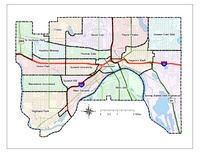Frogtown
| Thomas-Dale | |
|---|---|
| Neighborhood | |

The Church of St. Agnes, the spire and bells of which are prominent throughout the neighborhood.
|
|
| Nickname(s): Frogtown | |
 Map of neighborhoods in the city of Saint Paul, Minnesota |
|
| Country | United States |
| State | Minnesota |
| County | Ramsey |
| City | Saint Paul |
| Area | |
| • Total | 1.714 sq mi (4.44 km2) |
| Population (2010) | |
| • Total | 17,049 |
| • Density | 9,900/sq mi (3,800/km2) |
| Time zone | CST (UTC-6) |
| • Summer (DST) | CDT (UTC-5) |
| ZIP code | 55101, 55103, 55104 |
| Area code(s) | 651 |
| Website | http://www.frogtownmn.org/ |
Frogtown is a neighborhood in Saint Paul in the U.S. state of Minnesota. Built around University Avenue, the Thomas-Dale neighborhood is colloquially known as Frogtown (German: Froschburg). Historically, Frogtown was a subsection of the current Thomas-Dale neighborhood. It is bordered by University Avenue on the south, the Burlington Northern Railroad tracks to the north, Lexington Parkway on the west and Rice Street on the east.
The neighborhood was first settled 1860–1880 as the downtown area outgrew its borders. Workers on the St. Paul and Pacific Railroad, now BNSF Railway, which was built just to the north of the neighborhood sought housing nearby. Minnesota's first successful locomotive run occurred on these tracks in 1882. Shortly thereafter the Jackson Street Railroad Shops were built just northeast of Frogtown. The Jackson Street Shops were then joined by other railroad related industries in the area including the Saint Paul Foundry, built near Como and Western Avenues, providing additional employment opportunities for residents.
Residential development moved westward through the neighborhood as Polish, Scandinavian, German, and Irish immigrants took blue-collar jobs in the area. They built modest wood frame and brick houses on small lots in the neighborhood. Urban renewal has wiped out many of these homes, but working-class Victorian homes from the 1880s are extant, some adorned with arched window and door openings, brick window hoods, and frilly intact open porches.
...
Wikipedia
